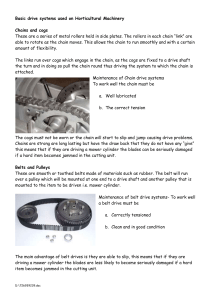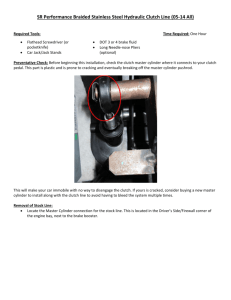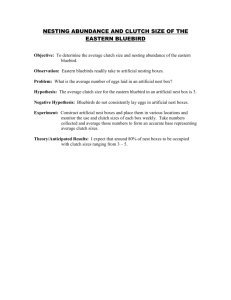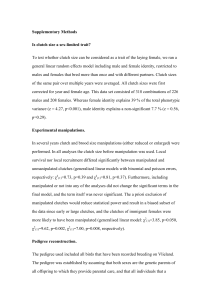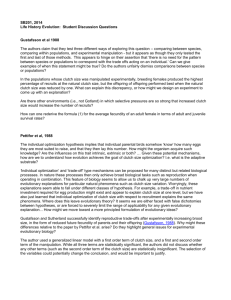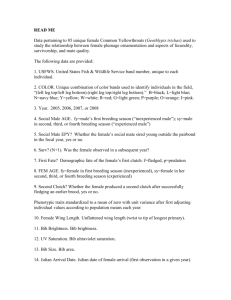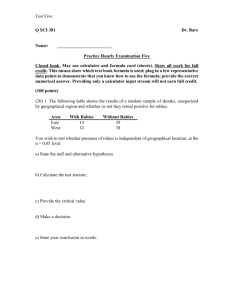CL-11 - 4 8 15 16 23 42
advertisement
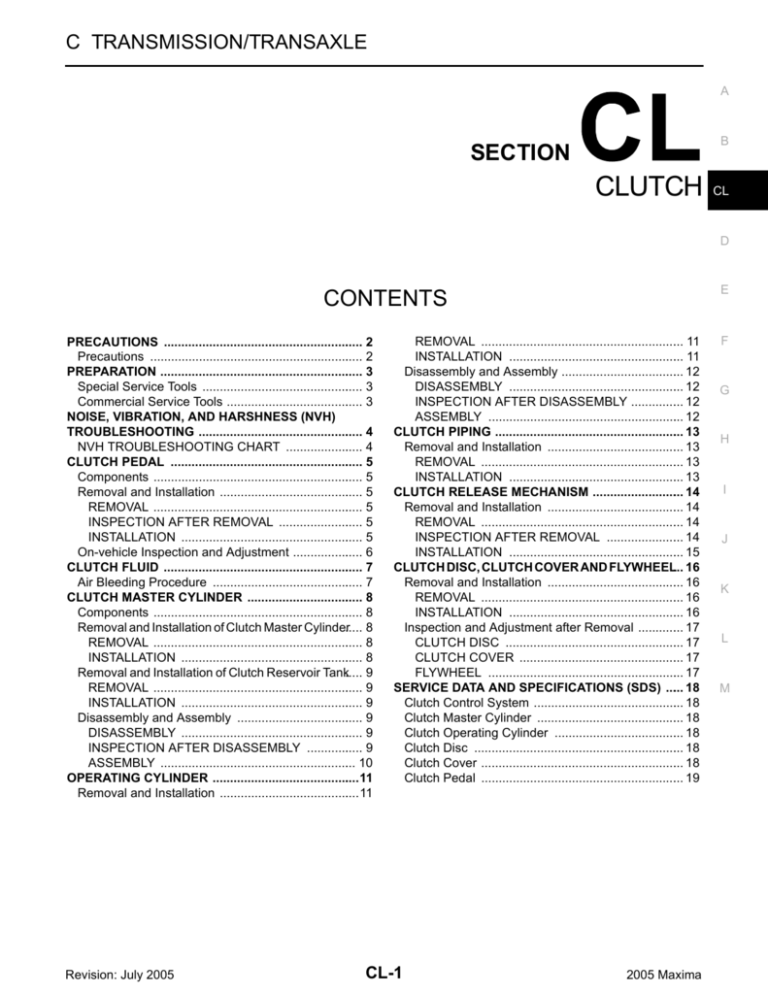
C TRANSMISSION/TRANSAXLE A B SECTION CLUTCH CL D E CONTENTS PRECAUTIONS .......................................................... 2 Precautions .............................................................. 2 PREPARATION ........................................................... 3 Special Service Tools ............................................... 3 Commercial Service Tools ........................................ 3 NOISE, VIBRATION, AND HARSHNESS (NVH) TROUBLESHOOTING ................................................ 4 NVH TROUBLESHOOTING CHART ....................... 4 CLUTCH PEDAL ........................................................ 5 Components ............................................................. 5 Removal and Installation .......................................... 5 REMOVAL ............................................................. 5 INSPECTION AFTER REMOVAL ......................... 5 INSTALLATION ..................................................... 5 On-vehicle Inspection and Adjustment ..................... 6 CLUTCH FLUID .......................................................... 7 Air Bleeding Procedure ............................................ 7 CLUTCH MASTER CYLINDER .................................. 8 Components ............................................................. 8 Removal and Installation of Clutch Master Cylinder..... 8 REMOVAL ............................................................. 8 INSTALLATION ..................................................... 8 Removal and Installation of Clutch Reservoir Tank..... 9 REMOVAL ............................................................. 9 INSTALLATION ..................................................... 9 Disassembly and Assembly ..................................... 9 DISASSEMBLY ..................................................... 9 INSPECTION AFTER DISASSEMBLY ................. 9 ASSEMBLY ......................................................... 10 OPERATING CYLINDER ...........................................11 Removal and Installation .........................................11 Revision: July 2005 REMOVAL ........................................................... 11 INSTALLATION ................................................... 11 Disassembly and Assembly .................................... 12 DISASSEMBLY ................................................... 12 INSPECTION AFTER DISASSEMBLY ................ 12 ASSEMBLY ......................................................... 12 CLUTCH PIPING ....................................................... 13 Removal and Installation ........................................ 13 REMOVAL ........................................................... 13 INSTALLATION ................................................... 13 CLUTCH RELEASE MECHANISM ........................... 14 Removal and Installation ........................................ 14 REMOVAL ........................................................... 14 INSPECTION AFTER REMOVAL ....................... 14 INSTALLATION ................................................... 15 CLUTCH DISC, CLUTCH COVER AND FLYWHEEL... 16 Removal and Installation ........................................ 16 REMOVAL ........................................................... 16 INSTALLATION ................................................... 16 Inspection and Adjustment after Removal .............. 17 CLUTCH DISC .................................................... 17 CLUTCH COVER ................................................ 17 FLYWHEEL ......................................................... 17 SERVICE DATA AND SPECIFICATIONS (SDS) ...... 18 Clutch Control System ............................................ 18 Clutch Master Cylinder ........................................... 18 Clutch Operating Cylinder ...................................... 18 Clutch Disc ............................................................. 18 Clutch Cover ........................................................... 18 Clutch Pedal ........................................................... 19 CL-1 2005 Maxima F G H I J K L M PRECAUTIONS PRECAUTIONS Precautions PFP:00001 ECS009SG Use recommended brake fluid when adding fluid to clutch reservoir tank. Refer to MA-9, "RECOMMENDED FLUIDS AND LUBRICANTS" . ● Never reuse fluid drained from clutch system. ● Be careful not to splash brake fluid on painted areas. ● When removing and installing clutch piping, use Tool. ● Use new brake fluid to clean or wash all parts of master cylinder and operating cylinder. ● Never use mineral oils such as gasoline or kerosene. It will ruin the rubber parts of the hydraulic system. WARNING: After cleaning clutch disc, wipe it with a dust collector. Do not use compressed air. ● SBR686C Revision: July 2005 CL-2 2005 Maxima PREPARATION PREPARATION Special Service Tools PFP:00002 A ECS009SH The actual shapes of Kent-Moore tools may differ from those of special service tools illustrated here. Tool number Description (Kent-Moore No.) Tool name ST20630000 (J-26366) Clutch aligning bar B Installing clutch cover and clutch disc a: 15.8 mm (0.622 in) dia. b: 22.9 mm (0.902 in) dia. c: 45.0 mm (1.772 in) CL D NT405 ST20050240 ( — ) Diaphragm spring adjusting wrench Adjusting unevenness of diaphragm spring of clutch cover a: 150 mm (5.91 in) b: 25 mm (0.98 in) NT404 KV32101000 (J-25689-A) Pin punch E F G Removing and installing spring pin a: 4 mm (0.16 in) dia. H I NT410 Commercial Service Tools ECS009SI J Tool name Description 1. Flare nut crowfoot 2. Torque wrench Removing and installing clutch piping a: 10 mm (0.39 in) K L NT360 Power tool Loosening bolts and nuts M PBIC0190E Revision: July 2005 CL-3 2005 Maxima Symptom Revision: July 2005 Clutch grabs/chatters Clutch pedal spongy 1 Clutch noisy 2 3 4 CL-4 CL-12 OPERATING CYLINDER PISTON CUP (Damaged) CL-17 CL-17 CL-17 CL-17 CL-17 CL-17 CL-17 CL-17 CLUTCH DISC (Dirty or burned) CLUTCH DISC (Oily) CLUTCH DISC (Worn out) CLUTCH DISC (Hardened) CLUTCH DISC (Lack of spline grease) DIAPHRAGM SPRING (Damaged) DIAPHRAGM SPRING (Out of tip alignment) PRESSURE PLATE (Distortion) FLYWHEEL (Distortion) NOISE, VIBRATION, AND HARSHNESS (NVH) TROUBLESHOOTING NVH TROUBLESHOOTING CHART 2 2 2 4 5 2 5 5 5 5 2 2 5 3 5 6 6 CL-17, "FLYWHEEL" CL-17 CLUTCH DISC (Lining broken) EM-117, "Removal and Installation" CL-9 MASTER CYLINDER PISTON CUP (Damaged) CL-17 1 CLUTCH DISC (Runout is excessive) Clutch does not disengage CL-17 1 CLUTCH DISC (Out of true) 1 2 CL-14 1 RELEASE BEARING (Worn, dirty or damaged) Clutch slips 2 ENGINE MOUNTING (Loose) CL-7 CLUTCH LINE (Air in line) SUSPECTED PARTS (Possible cause) CL-6 Reference page CLUTCH PEDAL (Inspection and adjustment) NOISE, VIBRATION, AND HARSHNESS (NVH) TROUBLESHOOTING PFP:00003 ECS009SJ Use the chart below to help you find the cause of the symptom. The numbers indicate the order of the inspection. If necessary, repair or replace these parts. 2 7 2005 Maxima CLUTCH PEDAL CLUTCH PEDAL Components PFP:46540 A ECS009SK B CL D E F G WCIA0200E 1. Clutch pedal bracket 2. ASCD clutch switch 3. Clutch interlock switch 4. Clutch pedal 5. Bushing 6. Clevis pin 7. Assist spring 8. Stopper rubber 9. Bushing H 10. Snap pin Removal and Installation ECS009SL I REMOVAL 1. 2. 3. 4. 5. Remove the driver side lower instrument panel. Refer to IP-15, "Lower Driver Instrument Panel" . Disconnect the ASCD clutch switch and the clutch interlock switch. Refer to PG-62, "HARNESS CONNECTOR" . Remove the clutch pedal clevis pin. Remove clutch pedal assembly mounting bolts and nuts. Remove clutch pedal assembly. INSPECTION AFTER REMOVAL ● ● J K L Inspect for clutch bending, damage and welding cracks. Replace if necessary. Make sure that the assist spring and return spring have not lost their spring. Replace if necessary. M INSTALLATION Installation is in the reverse order of removal. ● After installation, refer to CL-6, "On-vehicle Inspection and Adjustment" . Revision: July 2005 CL-5 2005 Maxima CLUTCH PEDAL On-vehicle Inspection and Adjustment 1. a. b. c. d. 2. a. b. ECS009SM Check to see if the clutch pedal clevis pin floats freely in the bore of the clutch pedal. It should not be bound by the clevis or clutch pedal. If the pin is not free, check that the ASCD switch is not applying pressure to the clutch pedal causing the pin to bind. To adjust, loosen the ASCD switch bolt lock nut and turn the ASCD switch. Tighten the lock nut. Verify that the clutch pedal clevis pin floats freely in the bore of the clutch pedal. It should not be bound by the clevis or clutch pedal. If the pin is still not free, remove the pin and check for deformation or damage. Replace the pin if necessary. Leave the pin removed for step 2. Check the clutch pedal stroke for free range of movement. With the clutch pedal clevis pin removed, manually move the pedal up and down to determine if it moves freely. If any sticking is noted, replace the related parts (clutch pedal, pedal bracket, assist spring and bushing). Reassemble the pedal and re-verify that the clevis pin floats freely in the bore of the pedal. WCIA0423E 3. Adjust the clearance “C” while fully depressing the clutch pedal (with the clutch interlock switch) as shown. Clearance "C" 4. a. b. : 0.1 – 1.0 mm (0.004 – 0.039 in) Check the clutch hydraulic system components (clutch master cylinder, clutch operating cylinder, clutch withdrawal lever, clutch release bearing, etc.) for sticking or binding. If any sticking or binding is noted, repair or replace the related parts as necessary. If any hydraulic system repair was necessary, bleed the clutch hydraulic system. Refer to CL-7, "Air Bleeding Procedure" . NOTE: Do not use a vacuum assist or any other type of power bleeder on this system. Use of a vacuum assist or power bleeder will not purge all of the air from the system. SCL800 Revision: July 2005 CL-6 2005 Maxima CLUTCH FLUID CLUTCH FLUID Air Bleeding Procedure PFP:00017 A ECS009SN NOTE: Do not use a vacuum assist or any other type of power bleeder on this system. Use of a vacuum assist or B power bleeder will not purge all the air from the system. ● Bleed air according to the following procedure. ● Carefully monitor fluid level at reservoir tank during bleeding operation. CL ● When bleeding the air from the clutch fluid, first bleed the air from the operating cylinder air bleed valve and then from the bleed connector air bleed valve. 1. Top off reservoir with new recommended brake fluid. Refer to MA-9, "RECOMMENDED FLUIDS AND D LUBRICANTS" . 2. Connect a transparent vinyl tube and container to the air bleeder valve on the clutch operating cylinder. E F G WCIA0199E 3. 4. 5. 6. Air bleeder valve 7. H Fully depress the clutch pedal several times. With clutch pedal depressed, open the bleeder valve to release air. Close the bleeder valve. Repeat steps 3 through 5 until clear brake fluid comes out of the air bleeder valve. I : 5.9 – 9.8 N·m (0.6 – 1.0 kg-m, 52 – 87 in-lb) J Perform steps 1 through 6 for bleeding air from the air bleeder valve on the bleed connector. K L M LCIA0102E Revision: July 2005 CL-7 2005 Maxima CLUTCH MASTER CYLINDER CLUTCH MASTER CYLINDER Components PFP:30610 ECS009SO WCIA0415E 1. Clutch master cylinder 2. Return spring 3. Piston assembly 4. Push rod 5. Stopper 6. Stopper ring 7. Clevis 8. Hose clamp 9. Hose 10. Reservoir cap 11. Reservoir tank 13. Nipple 14. Pin 12. Bracket Removal and Installation of Clutch Master Cylinder ECS00AGR REMOVAL 1. 2. 3. 4. 5. Drain the brake fluid from the clutch hydraulic system. CAUTION: Do not splash brake fluid on painted areas; it may cause paint damage. If brake fluid is splashed on painted areas, wash it away with water immediately. Remove clutch line using a flare nut wrench. Remove hose clamp and hose from clutch master cylinder. Remove snap pin from clevis pin, then remove clevis pin from push rod and clevis. Remove the clutch master cylinder nuts, then remove the clutch master cylinder from the vehicle. INSTALLATION 1. Check position of clevis and push rod. If measurement is outside standard length, adjust position of clevis and push rod. Length “L” 2. : 119.5 mm (4.70 in) Connect the clutch line to the master cylinder assembly, and hand-tighten the flare nut. SCIA5158E 3. Install the master cylinder assembly, tighten the nuts to specification. Clutch master cylinder nuts 4. 5. : 7.8 – 10.8 N·m (0.8 – 1.6 kg-m, 9 – 12 ft-lb) Install clutch reservoir tank hose and hose clamp to the clutch master cylinder assembly. Tighten the clutch line flare nut to specification using a flare nut torque wrench. Revision: July 2005 CL-8 2005 Maxima CLUTCH MASTER CYLINDER Clutch line flare nut 6. 7. 8. : 15 - 18 N·m (1.5 – 1.8 kg-m, 11 – 13 ft-lb) A Attach clevis and clevis pin to clutch pedal. Attach snap pin to clevis pin. Inspect and adjust the clutch pedal and bleed the air from the clutch hydraulic system. Refer to CL-6, "Onvehicle Inspection and Adjustment" and CL-7, "Air Bleeding Procedure" . Removal and Installation of Clutch Reservoir Tank ECS00AGS REMOVAL 1. 2. 3. Drain the brake fluid from the clutch hydraulic system. CAUTION: Do not splash brake fluid on painted areas; it may cause paint damage. If brake fluid is splashed on painted areas, wash it away with water immediately. Remove the clamp, then remove the hose from the clutch reservoir tank. Remove the clutch reservoir tank to bracket nuts, then remove the clutch reservoir tank from the vehicle. B CL D E INSTALLATION 1. 2. 3. Install the clutch reservoir tank and nuts to the bracket and hand-tighten. Install the hose and clamp to the clutch reservoir tank. Tighten the clutch reservoir tank nuts to specified torque. Reservoir tank bracket bolts Reservoir tank to bracket nuts F G : 5.1 – 6.5 N·m (0.52 – 0.66 kg-m, 46 – 57 in-lb) : 2.9 – 5.9 N·m (0.3 – 0.6 kg-m, 26 – 52 in-lb) Disassembly and Assembly ECS009SP H DISASSEMBLY 1. 2. 3. 4. 5. Loosen the push rod lock nut "A" to remove clevis and lock nut "A". CAUTION: Clutch pedal height is controlled with position of clevis and push rod. Remove pin and nipple from cylinder body. Remove the dust cover. Remove the stopper ring and stopper, and remove the push rod from the cylinder body. During removal, keep the push rod depressed, to prevent the piston inside the master cylinder from popping out. Remove the piston assembly and return spring from the cylinder body. I J K SCL725 L INSPECTION AFTER DISASSEMBLY M Inspect for the following, and replace parts as necessary. ● Damage, wear, rust, and pinholes on the cylinder inner wall ● Damage and deformation of the reservoir tank ● Weak spring ● Crack and deformation of the dust cover Revision: July 2005 CL-9 2005 Maxima CLUTCH MASTER CYLINDER ASSEMBLY 1. 2. 3. 4. 5. 6. Apply rubber lubricant to the sliding part of piston assembly, and insert return spring and piston assembly. Install the stopper to push rod. Install a new stopper ring while keeping piston assembly depressed by hand, so that piston assembly will not pop out. CAUTION: Stopper ring cannot be reused. Always use a new stopper ring to assemble. Install dust cover. Install nipple and pin to cylinder body. Install clevis to push rod. Check and adjust position of clevis on push rod. After adjusting "L", tighten lock nut to specification, refer to CL-8, "Components" . Length "L" : 119.5 mm (4.70 in) SCIA5158E Revision: July 2005 CL-10 2005 Maxima OPERATING CYLINDER OPERATING CYLINDER Removal and Installation PFP:30620 A ECS009SQ B CL D E F G WCIA0196E 1. Cylinder body 2. Piston spring 3. Piston cup 4. Piston 5. Push rod 6. Dust cover 7. Air bleeder 8. Union bolt 9. Copper washers 10. Clutch hose H I REMOVAL 1. 2. 3. Drain brake fluid from hydraulic clutch system. CAUTION: Do not to splash brake fluid on painted areas; it may cause paint damage. If brake fluid is splashed on painted areas, wash it away with water immediately. Remove union bolt and clutch hose from operating cylinder. Remove operating cylinder mounting bolts, and remove cylinder from vehicle. J K L M WCIA0197E INSTALLATION Installation is in the reverse order of removal. CAUTION: ● Install the clutch hose without twisting it. ● The copper washers of the union bolt cannot be reused. Always use new copper washers when installing the clutch hose. ● After installation, bleed the air from the clutch hydraulic system. Refer to CL-7, "Air Bleeding Procedure" . Revision: July 2005 CL-11 2005 Maxima OPERATING CYLINDER Disassembly and Assembly ECS009SR DISASSEMBLY ● Remove dust cover, and remove piston assembly from cylinder body. INSPECTION AFTER DISASSEMBLY Inspect for following, and replace parts as necessary. ● Damage, foreign material, wear, rust, and pinholes on the cylinder inner surface, piston, and sliding part of piston cup ● Weak spring ● Crack and deformation of dust cover ASSEMBLY Assembly is in the reverse order of disassembly. ● Apply recommended rubber grease to piston cup and piston before assembly. Revision: July 2005 CL-12 2005 Maxima CLUTCH PIPING CLUTCH PIPING Removal and Installation PFP:30650 A ECS009SS REMOVAL 1. 2. 3. 4. 5. Remove fuel filter mounting bracket. Remove air cleaner and air duct. Refer to EM-16, "Removal and Installation" . Drain the brake fluid from the hydraulic clutch system. CAUTION: Do not to splash brake fluid on painted areas; it may cause paint damage. If brake fluid is splashed on painted areas, wash it away with water immediately. Remove flare nut using a flare nut wrench. Remove clutch hose and clutch tube. B CL D WCIA0205E E INSTALLATION 1. When installing clutch hose to bracket, face lock plate in the correct direction as shown to secure clutch hose. CAUTION: Install clutch hose without twisting or bending it. F G H SCL730 I 2. Tighten flare nut to the specification, using a flare nut wrench. Flare nut 3. : 15 – 18 N·m (1.5 – 1.8 kg-m, 11 – 13 ft-lb) J CAUTION: Be careful not to damage flare nut and clutch tube. Install clutch hose to operating cylinder, and tighten the union bolt to the specification. K Clutch hose union bolt 4. : 17 – 20 N·m (1.7 – 2.0 kg-m, 12 – 14 ft-lb) After installation, bleed the air from the clutch hydraulic system. Refer to CL-7, "Air Bleeding Procedure" . L M Revision: July 2005 CL-13 2005 Maxima CLUTCH RELEASE MECHANISM CLUTCH RELEASE MECHANISM Removal and Installation PFP:30502 ECS009ST WCIA0408E 1. Snap spring 2. Release bearing non-separate type 4. Withdrawal lever 5. Dust cover 3. Holder spring CAUTION: When installing the holder spring pay attention to the direction of the bearing retainer. REMOVAL 1. 2. 3. 4. Remove manual transaxle from vehicle. Refer to MT-16, "Removal and Installation" . Move withdrawal lever enough to remove release bearing from input shaft, then remove release bearing from withdrawal lever. Remove withdrawal lever snap spring. Pull out withdrawal lever and remove dust cover. INSPECTION AFTER REMOVAL ● ● ● Replace the release bearing if it is seized, damaged, faulty in rotation direction, or has poor aligning function. Replace the withdrawal lever if its contact surface is worn abnormally. Replace the dust seal if it is deformed or cracked. SCL733 Revision: July 2005 CL-14 2005 Maxima CLUTCH RELEASE MECHANISM INSTALLATION A Installation is in the reverse order of removal. NOTE: ● Clean old grease and abrasive materials off the grease application areas. ● Apply grease to the specified points as shown. B CL D E SCL815 Apply approximately 1 mm (0.04 in) thick coat of clutch sleeve grease to withdrawal lever and holder spring frictional surfaces. ● Apply a coat of clutch sleeve grease to the grooves on contact surfaces of the withdrawal lever ball pin and inner surface of release bearing; make sure that grease is flush with grooves. ● Apply a thin coat of clutch sleeve grease to release bearing frictional surface. After grease application, install release bearing. Wipe off excess grease forced out during bearing installation. CAUTION: ● Before installing the manual transaxle to the vehicle, check that each sliding surface slides smoothly by operating withdrawal lever. ● When assembling, make sure that both ends of the snap spring touch the end face of the withdrawal lever. ● Be careful with the orientation of the installation. ● F G H I J K PCIB0837E L M Revision: July 2005 CL-15 2005 Maxima CLUTCH DISC, CLUTCH COVER AND FLYWHEEL CLUTCH DISC, CLUTCH COVER AND FLYWHEEL Removal and Installation PFP:30100 ECS009SU WCIA0147E 1. Flywheel 2. Clutch disc 4. Washer 5. Main drive shaft 3. Clutch cover CAUTION: ● Do not clean the clutch disc with solvent. ● When installing, do not get grease from the main drive shaft onto the clutch disc friction surface. ● If the flywheel is removed, align the dowel pin with the smallest hole of flywheel. Refer to EM-126, "ASSEMBLY" . REMOVAL 1. 2. Remove the manual transaxle from the vehicle. Refer to MT-16, "Removal and Installation" . Evenly loosen the bolts holding the clutch cover, using power tool. Then remove the clutch cover and the clutch disc. INSTALLATION Installation is in the reverse order of removal. ● Insert Tool into clutch disc hub when installing clutch cover and disc. ● Be careful not to allow grease to contaminate clutch facing. ● Tighten the clutch cover bolts in the numerical order as shown, in two steps. First step Final step : 10 – 20 N·m (1.0 – 2.0 kg-m, 7 – 14 ft-lb) : 35 – 44 N·m (3.5 – 4.5 kg-m, 26 – 32 ft-lb) SCL600-C Revision: July 2005 CL-16 2005 Maxima CLUTCH DISC, CLUTCH COVER AND FLYWHEEL Inspection and Adjustment after Removal ECS009SV A CLUTCH DISC ● Check clutch disc for wear of facing. Wear limit of facing surface to rivet head : 0.3 mm (0.012 in) B CL D SCL229 ● Check clutch disc for backlash of spline and runout of facing. Maximum backlash of spline (at outer edge of disc) Runout limit Distance of runout check point (from hub center) ● E : 1.0 mm (0.039 in) F : 0.7 mm (0.028 in) : 240 mm (9.45 in) G Check clutch disc for burns, discoloration or oil or grease leakage. Replace if necessary. SCL221 H CLUTCH COVER ● Check clutch cover installed on vehicle for unevenness of diaphragm spring toe height. Uneven limit ● I : 1.0 mm (0.039 in) If out of limit, adjust the height using Tool. J K SCL466-A FLYWHEEL ● ● Check contact surface of flywheel for slight burns or discoloration. Repair flywheel with emery paper. Check the flywheel runout. Refer to EM-148, "FLYWHEEL RUNOUT (M/T)" . M SCL349 Revision: July 2005 CL-17 L 2005 Maxima SERVICE DATA AND SPECIFICATIONS (SDS) SERVICE DATA AND SPECIFICATIONS (SDS) Clutch Control System Type of clutch control PFP:00100 ECS009SW Hydraulic Clutch Master Cylinder ECS009SX Unit: mm (in) SCIA5158E Inner diameter 15.87 (5/8) Length "L" of clevis on pushrod 119.5 (4.70) Clutch Operating Cylinder ECS009SY Unit: mm (in) Inner diameter 17.46 (11/16) Clutch Disc ECS009SZ Model 250 Facing size (Outer dia. × inner dia. × thickness) 250 mm × 170 mm × 3.2 mm (9.84 in × 6.69 in × 0.126 in) Thickness of disc assembly (With load) 7.4 mm (0.291 in) with 8340 N (850 kg, 1875 lb) Wear limit of facing surface to rivet head 0.3 mm (0.012 in) Facing runout limit 0.7 mm (0.028 in) Distance of runout check point (from the hub center) 240 mm (9.45 in) Maximum spline backlash (at outer edge of disc) 1.0 mm (0.039 in) Clutch Cover ECS009T0 Model 250 Set load 8,340 N (850 kg, 1875 lb) Set height 40.5 mm (1.59 in) Uneven limit of diaphragm spring toe height 1.0 mm (0.039 in) Revision: July 2005 CL-18 2005 Maxima SERVICE DATA AND SPECIFICATIONS (SDS) Clutch Pedal ECS009T1 Unit: mm (in) A B CL D E F G H SCL800 Clearance “C” between pedal stopper rubber and clutch interlock switch threaded end while clutch pedal is fully depressed. 0.1 - 1.0 (0.004 - 0.039) I J K L M Revision: July 2005 CL-19 2005 Maxima SERVICE DATA AND SPECIFICATIONS (SDS) Revision: July 2005 CL-20 2005 Maxima
